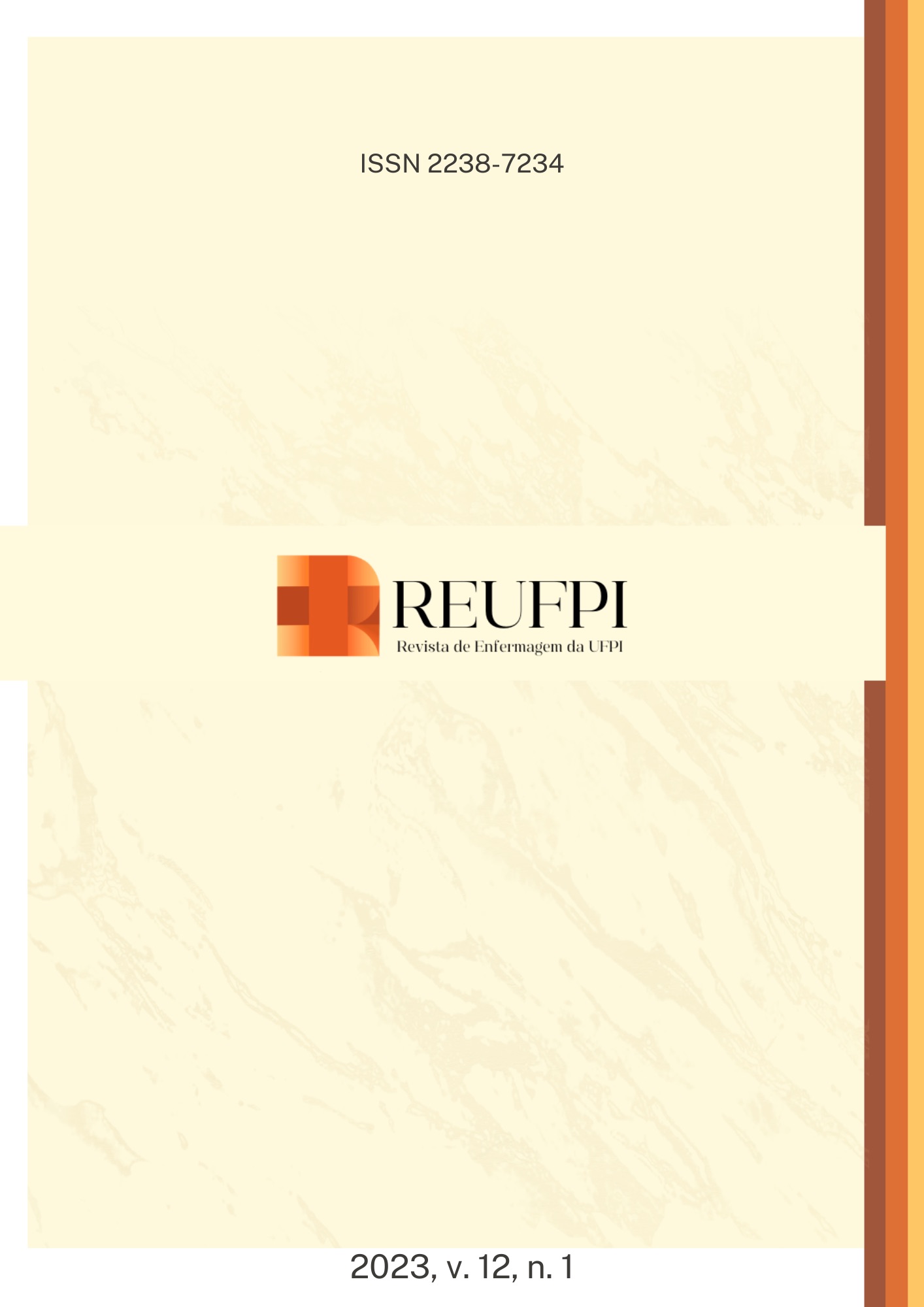Safe use of medications: learning needs and strengths for teaching mediated by virtual technologies
DOI:
https://doi.org/10.26694/reufpi.v12i1.4227Palavras-chave:
Education, Nursing, Patient Safety, Drug Therapy, TechnologyResumo
Objective: To identify the learning needs of undergraduate nursing students about patient safety and medication safety. Methods: Descriptive and cross-sectional study, developed from March 2019 to December 2020, with a non-probabilistic and intentional sample consisting of 45 undergraduate nursing students. Data were analyzed using descriptive statistics. Results: There was a predominance of female students (73.3%) with family income between 1 and 2 minimum wages. All confirmed having access to the internet, with a daily frequency of use by participants (93.3%). The smartphone was the most used device to access the internet (77.8%), with the home being the predominant place of access (80.0%). Regarding the learning needs about patient safety and medication safety, the classification “essential” stood out among the evaluated questions. Conclusion: The main identified learning needs of the participants were: working effectively as part of a team, understanding the systems and the effect of the complexity of patient care and defining the key concepts. In addition to that, there were weaknesses in differentiating between common terms in the medication administration process.
Referências
Organização Mundial de Saúde (OMS). Plano de ação global para a segurança do paciente 2021-2030: (traduzido para português). Português (Brasil) Em busca da eliminação dos danos
evitáveis nos cuidados de saúde. Genebra: Organização Mundial da Saúde; 2021.
World Health Organization (WHO). Conceptual Framework for the International Classification for Patient Safety [Internet]. 2019. Disponível em: https://apps.who.int/iris/bitstream/handle/10665/70882/WHO_IER_PSP_2010.2_eng.pdf.
Wachter RM. Compreendendo a segurança do paciente. Grupo A - Artmed 2010.
World Health Organization. The third WHO Global Patient Safety Challenge: Medication Without Harm. World Health Organization [Internet]. 2009. Disponível em: https://www.who.int/patientsafety/medication-safety/en/.
Lopes DS, Mascarenhas AMS, Santos NJS dos, Santana TDB, Souza TS, Borges JMP, et al. Notificações de erros de medicação em um hospital geral de urgência e emergência. Research, Society and Development. [Internet] 23;10(7):e32410716528. DOI: http://dx.doi.org/10.33448/rsd-v10i7.16528.
National Coordinating Council for Medication Error Reporting and Prevention (NCC MERP). About medication error. What is a medication error [Internet]. 2001. Disponível em: https://www.nccmerp.org/about-medication-errors
Mascarello A, Rodrigues ME, Araújo BN, Kruger DF, Mestri E, Massaroli A. Incidentes relacionados ao uso de medicamentos na atenção hospitalar. Enferm Foco [Internet]. 2022;13:e-202231. DOI: https://doi.org/10.21675/2357-707X.2022.v13.e-202231.
Basile LC, Santos A, Stelzer LB, Alves RC, Fontes CMB, Borgato MH, et al. Análise das ocorrências de incidentes relacionados aos medicamentos potencialmente perigosos dispensados em hospital de ensino. Revista Gaúcha de Enfermagem. 2019;40. DOI: https://doi.org/10.1590/1983-1447.2019.20180220.
Levett-Jones T, Andersen P, Bogossian F, Cooper S, Guinea S, Hopmans R, et al. A cross-sectional survey of nursing students’ patient safety knowledge. Nurse Education Today. [Internet]. 2020; 88:104372. DOI: https://doi.org/10.1016/j.nedt.2020.104372.
Mota RS, Silva VA, Mendes AS. Notificação de incidentes relacionados à cadeia medicamentosa em um hospital de ensino. Enferm Bras. [Internet]. 2022;21(5):543-55 DOI: https://doi.org/10.33233/eb.v21i5.4577.
Dimitriadou M, Merkouris A, Charalambous A, Lemonidou C, Papastavrou E. The knowledge about patient safety among undergraduate nurse students in Cyprus and Greece: a comparative study. BMC Nursing [Internet]. 2021;20(1). DOI: https://doi.org/10.1186/s12912-021-00610-6.
Alquwez N, Cruz JP, Alshammari F, Felemban EM Almazan JU, Tumala RB, et al. A multi‐university assessment of patient safety competence during clinical training among baccalaureate nursing students: A cross‐sectional study. Journal of Clinical Nursing[Internet]. 2019;28(9-10):1771–81. DOI: https://doi.org/10.1111/jocn.14790.
Ministério da Saúde (BR). Agência Nacional de Vigilância Sanitária. Anexo 03: protocolo de segurança na prescrição, uso e administração de medicamentos. Brasília (DF): Ministério da Saúde. 2013.
Malta M, Cardoso LO, Bastos FI, Magnanini MMF, Silva CMFP da. STROBE initiative: guidelines on reporting observational studies. Rev. saúde pública [Internet]. 2010. 1;44(3):559–65. DOI: https://doi.org/10.1590/s0034-89102010000300021.
Gonzaga LB, Alves PFW, Moreira BJ, Melo FAV, Ferreira Silva MRF, Vieira EP. Ensino-aprendizagem sobre períodos clínicos e mecanismos de parto: Rev Enferm Atual In Derm [Internet]. 2022;16;96(39). DOI: https://doi.org/10.31011/reaid-2022-v.96-n.39-art.1397.
Brasil. Resolução CNE/CES nº 3, de 7 de novembro de 2001. Diretrizes Curriculares Nacionais do Curso de Graduação em Enfermagem. 2001. Diário Oficial da União.
Brasil. Resolução CNS nº 573 que aprova o Parecer Técnico nº 28/2018 contendo recomendações do Conselho Nacional de Saúde (CNS) à proposta de Diretrizes Curriculares Nacionais (DCN) para o curso de graduação Bacharelado em Enfermagem. 2018. Diário Oficial da União.
Gonçalves LBB, Pinto AGA, Palácio MAV. Las tecnologías digitales de la información y comunicación en la enseñanza de enfermería. Revista Uruguaya de Enfermería. [Internet]. 2022;1;17(2). DOI: https://doi.org/10.33517/rue2022v17n2a5.
Organização Mundial de Saúde (OMS). Guia Curricular de Segurança do Paciente da Organização Mundial da Saúde: Edição Multiprofissional [Internet]. 2016. Disponível em: https://apps.who.int/iris/bitstream/handle/10665/44641/9788555268502-por.pdf.
Oliveira HKF de, Silva NC da. The meaning of patient safety for nursing students. Revista Brasileira de Enfermagem. [Internet]. 2022;75(5). DOI: https://doi.org/10.1590/0034-7167-2021-0567.
Cauduro GMR, Magnago TSB de S, Andolhe R, Lanes TC, Ongaro JD. Segurança do paciente na compreensão de estudantes da área da saúde. Revista Gaúcha de Enfermagem. [Internet]. 2017;38(2). DOI: https://doi.org/10.1590/1983-1447.2017.02.64818.
Gomes AT de L, Salvador PTC de O, Goulart CF, Cecilio SG, Bethony MFG. Innovative Methodologies to Teach Patient Safety in Undergraduate Nursing: Scoping Review. Aquichan. [Internet]. 2020; 13;20(1):1–14. DOI: https://doi.org/10.5294/aqui.2020.20.1.8.
Rodrigues GF, Castro TCS, Vitorio AMF. Segurança do paciente: conhecimento e atitudes de enfermeiros em formação. Revista Recien [Internet]. 2018; 20;8(24):3. DOI: https://doi.org/10.24276/rrecien2358-3088.2018.8.24.3-14.
Custódio IL, Lima FET, Pascoal LM, Barbosa LP, de Carvalho REFL, Almeida PC, et al. Training on intravenous medication administration in pediatric nursing: a before-after study. Revista da Escola de Enfermagem da USP. 2021;55.
Cárcamo AMP, Tourinho FSV, Alves TF. Risk factors in medication errors in a high-complexity chilean public hospital. Texto & Contexto - Enfermagem. [Internet]. 2020;29(spe). DOI: https://doi.org/10.1590/1980-265X-TCE-2019-0241.
Bohomol E. Patient safety education of the graduation in Nursing from the teaching perspective. Escola Anna Nery. [Internet]. 2019;23(2). DOI: https://doi.org/10.1590/2177-9465-EAN-2018-0364.
Downloads
Publicado
Como Citar
Edição
Seção
Licença
Copyright (c) 2023 Rev Enferm UFPI

Este trabalho está licenciado sob uma licença Creative Commons Attribution 4.0 International License.
Autores mantém os direitos autorais e concedem à REUFPI o direito de primeira publicação, com o trabalho licenciado sob a Licença Creative Commons Attibution BY 4.0 que permite o compartilhamento do trabalho com reconhecimento da autoria e publicação inicial nesta revista.

























